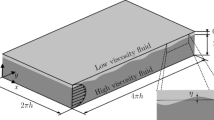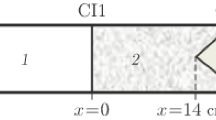Abstract
The external flow field over wave interface is reached by the aid of conformal transformation thought, and velocity boundary layer of inner flow field is deduced also, which gives fundamental description of shear stress over wave interface. The viscous drag coefficient is induced with considering the characteristics of interface wave, such as wave height, wave length and ratio between wave lengths of both ascending and descending semi periods, which significantly impact the velocity gradient over the wave interface that accounts for the differences in distribution of local shear stress. The influence of fluid flow is studied also, which gives support that the earlier separating point of the fluid flow over wave interface the stronger depression to the turbulent perturbation is made, and a reduced drag force arrived. There are otherness and commonness between fluid flow over wave interface and interface appearing in air-water wave stratified flow, and a new model is proposed to intrinsically construct the interfacial friction factor encountered in wave stratified flow. The models for viscous drag coefficient and interfacial friction factor are tested, different models are studied, predicted values are compared with experimental data and that computed by solving there-dimension unsteady Navier-Stokes equations, which gives proof that the values predicted by newly proposed models well fit the real values.























Similar content being viewed by others
Abbreviations
- A :
-
Cross-sectional area, projected area, wave height
- a :
-
Radius of circle cylinder
- C :
-
Coefficient
- c f,D :
-
Viscous drag coefficient
- c w :
-
Propagation speed of interface wave
- D :
-
Diameter
- F :
-
Complex potential of the flow
- F D,visc :
-
Viscous drag force
- f :
-
Dimensionless function, fluid
- f i :
-
Interface friction factor
- k A :
-
Modulus of wave
- p :
-
Coordinator transition number
- R :
-
Radius of curvature
- Re :
-
Reynolds number
- Re G :
-
Reynolds number of gas phase
- Re L :
-
Reynolds number of liquid phase
- Re G,M :
-
Modified Reynolds number of gas phase
- r λ :
-
r a /r d
- r λA :
-
λ/A
- s :
-
Algebraic sum of coefficients
- U :
-
Velocity component in x direction
- U G :
-
Gas velocity
- U L :
-
Liquid velocity
- u :
-
Velocity component in x direction
- u * :
-
Friction velocity
- v :
-
Velocity component in y direction
- x,y :
-
Rectangular spatial coordinates
- y x :
-
Section profile of circle cylinder
- α :
-
Phase holdup, radius angle
- θ :
-
Radius angle, phase position angle
- λ :
-
Wave length of interface wave
- τ :
-
Shear stress
- ρ :
-
Density
- μ :
-
Dynamic viscosity
- ν :
-
Kinematic viscosity
- λ a :
-
Wave length of ascending semi period
- λ d :
-
Wave length of descending semi period
- ζ :
-
Complex coordinate
- ψ :
-
Stream function
- η :
-
Dimensionless variable
- Γ :
-
Velocity circulation
- G :
-
Gas phase
- i :
-
Interface
- L :
-
Liquid phase
References
Taitel Y, Dukler AE (1976) A model for predicting flow regime transitions in horizontal and near horizontal gas liquid flow. AICHE J 22:47–55
Kowalski JE (1987) Wall and interfacial shear stress in stratified flow in a horizontal pipe. AICHE J 32:274–281
Spedding PL, Hand NP (1997) Prediction in stratified gas-liquid co-current flow in horizontal pipelines. Int J Heat Mass Transf 40(8):1923–1935
Hart J, Hamersma PJ, Fortuin JMH (1989) Correlations predicting frictional pressure drop and liquid during horizontal gas liquid pipe flow with a small liquid holdup. Int J Multiphase Flow 15:947–964
Chen XT, Cai XD, Brill JP (1997) Gas-Liquid Stratified Wavy Flow in Horizontal Pipelines. ASME J Energy Resour Technol 119(4):209–216
Ullmann A, Goldstien A, Zamir M, Brauner N (2004) Closure relations for the shear stresses in two-fluid models for stratified laminar flows. Int J Multiphase Flow 30:877–900
Ullmann A, Brauner N (2006) Closure relations for two-fluid models for two-phase stratified smooth and stratified wavy flows. Int J Multiphase Flow 32:82–105
Fore LB, Beus SG, Bauer RC (2000) Interfacial friction in gas-liquid annular flow: analogies to full and transition roughness. Int J Multiphase Flow 26:1755–1769
Wongwises S, Kongkiatwanitch W (2001) Interfacial friction factor in vertical upward gas-liquid annular two-phase flow. Int Commun Heat Mass Transfer 28:323–336
Tzotzi C, Andritsos N (2013) Interfacial shear stress in wavy stratified gas-liquid flow in horizontal pipes. Int J Multiphase Flow 54:43–54
Guangjun L (1996) Investigation on the Characteristics of Interfacial Waves in Gas-liquid Two-phase Flow through Channels. Ph.D. Thesis, Xian Jiaotong University, Xian
Shi J, Kocamustafaogullari G (1994) Interfacial measurements in horizontal stratified flow pattern. Nucl Eng Des 149:81–96
Biberg D, Halvorsen G (2000) Wall and interfacial shear stress in pressure driven two-phase laminar stratified pipe flow. Int J Multiphase Flow 26:1645–1673
Ayati AA, Kolaas J, Jensen A, Johnson GW (2014) A PIV investigation of stratified gas-liquid flow in a horizontal pipe. Int J Multiphase Flow 55:129–143
Salvetti M, Damiani R, Beux F (2001) Drag prediction over steep sinusoidal wavy surfaces. Phys Fluids 13:2728–2731
Mascarenhas N, Lee H, Mudawar I (2015) Experimental and computational investigation of interfacial shear along a wavy two-phase interface. Int J Heat Mass Transf 85:265–280
Cengel YA, Turner RH (2001) Fundamentals of Thermal-Fluids Sciences. McGrawHill, New York
Schlichting H (1979) Boundary-layer Theory. McGraw-Hill, New York
Kataoka I, Ishii M, Mishima K (1983) Generation and size distribution of droplet in annular two-phase flow. J Fluids Eng 105:230–239
Acknowledgements
The authors gratefully acknowledge the financial supports by National Natural Science Foundation of China (No.51527808).
Author information
Authors and Affiliations
Corresponding author
Additional information
Publisher’s note
Springer Nature remains neutral with regard to jurisdictional claims in published maps and institutional affiliations.
Appendices
Appendix 1
There is no simple trigonometric function to describe the interface profile appearing in the gas-liquid two-phase wave stratified flow, instead, a more complicated one is needed. Considering the complicated interface profile, complicated formulations are assumed as follows.
The variables ×0 and y is function of phase angles θ0 and θ1 respectively that referred in equation (A.1), the variable wavelength λ0 varies periodically with phase angle θ0. To some extent, the fluid flow over wave interface can be treated as fluid flow around a cylinder, which takes simple functions to describe the flow field out of the cylinder. There are two steps needs to be done to conduct the transform.
-
Step.1
The phase angles θ0 and θ1 should be correlated, a same phase angle should be defined to describe the variables x0 and y. In the synthesis the analysis above, the relationship between the phase angles is defined as follows, and new x1 coordinate axis is correspondingly defined.
-
Step.2
The variable wavelength should be uniform, and the interface wave can be described by new functions in x2-y coordinate system.
The interface profile of cylinder is actually circle arc, its horizontal and vertical coordinates value are functions of the same radius. As a result, a new coordinate transform is made and the wave interface is transformed into a circle arc.
Appendix 2
Viscous drag coefficient is function of fluid flow parameters, and can be deduced basing equation (13).
It is difficult to define characteristic length to solve the equation (B.1). However, it can be eliminated by using of Reynolds number ReD, where the characteristic length is substituted by equivalent diameter D. Considering the flow area is constant, the equivalent diameter D calculated with flow area is constant also. Consequently, the calculation of viscous drag coefficient can be deduced as follows.
The second order derivative f′′(0) is calculated by solving the equation (12.a), and the other parameters are functions of interface profile.
Appendix 3
For the flow field with interface length of x, the mean value of shear stress over the interface can be deduced as follows.
The interfacial shear stress is influenced by the two fluids, and it is correlated as function of the fluids properties and fluids velocities to solve the Double Fluids Model. A large number of experiments data has proved that the liquid velocity is much smaller than that of gas phase for stratified flow. As a result, the equation (21) can be simplified as follows.
The mechanisms of the mean value of shear stress over the interface \( \overline{\tau_i} \) and interfacial shear stress τi are the same. It is reasonable to acknowledge that the interfacial shear stresses calculated by equation (C.1) and equation (C.1) should be identical while expanding the equation (C.1) to calculate that working on the interface in gas-liquid two-phase wave stratified flow. Substituting the equation (C.2) into equation (C.1), interfacial friction factor could be related with viscous drag coefficient, and the relationship is written as follows.
The viscous drag coefficients are computed by the newly proposed model, and it is compared with experimental values of interfacial friction factors. Finally, the validity of equation (C.3) was verified, and the constant number C = 1.0.
Rights and permissions
About this article
Cite this article
Wang, Y., Guo, L. Theoretical and experimental research on interfacial shear stress and interfacial friction factor of gas-liquid two-phase wavy stratified flow in horizontal pipe. Heat Mass Transfer 55, 2117–2135 (2019). https://doi.org/10.1007/s00231-019-02560-x
Received:
Accepted:
Published:
Issue Date:
DOI: https://doi.org/10.1007/s00231-019-02560-x




